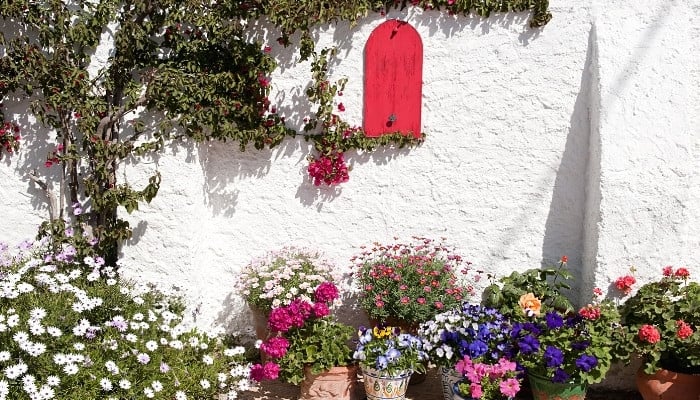Spain captivates tourists with vibrant, colorful flowers blooming throughout its city streets and secluded hillsides, gently swaying in the breeze or cascading over walls and window frames.
In the right growing conditions, you can bring a touch of the Mediterranean to your home garden too. Here are 21 beautiful Spanish-native blooms, their suitable growing zones, and fun facts!
#1. Pomegranate Flower
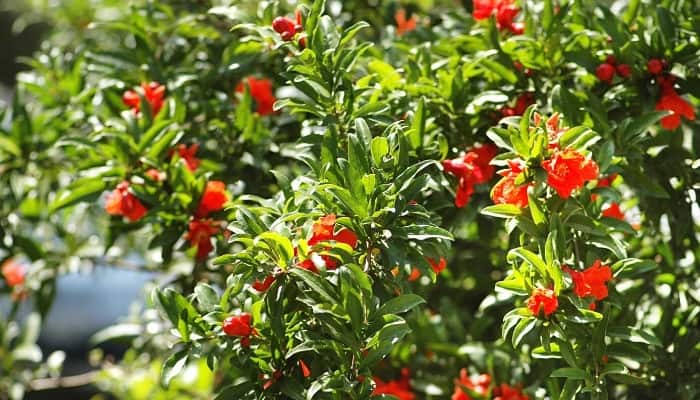
The pomegranate flower originated in Persia and its multiple seeds are said to represent ‘rebirth’ in Greek mythology due to an association with the goddess Persephone in her pursuit to reincarnate lost souls.
It is often used in weddings as an affirmation of new chapters and possibilities – often depicted in Spanish art and literature in this way.
Fertilize lightly as they are accustomed to poor native soil.
- Botanical Name: Punica granatum
- Meaning: Rebirth
- Common Colors: Pink, orange, red
- Popular Varieties: ‘Flore Pleno’, ‘Wonderful’
- Best for Growing Zones: 7-10
- Light Requirements: 8-10 hours full sun
#2. Red Carnation
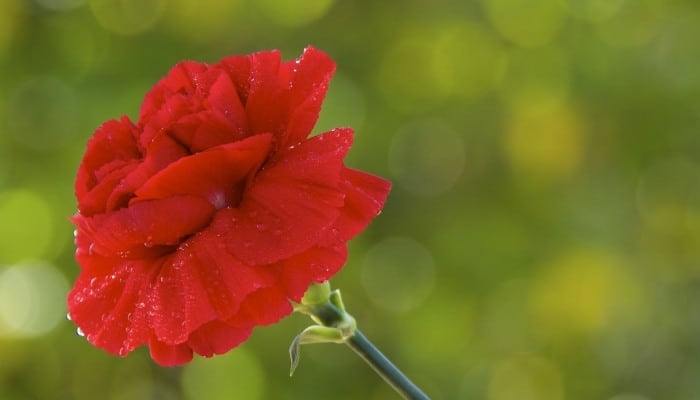
The national flower of Spain, red carnations represents affection between two lovers, but they have also been used in a biblical context to represent Christ’s crown of thorns and a symbol of respect for mothers.
Red carnations have a sweet, earthly scent and will bloom long into late summer when spent blossoms are dead-headed to stimulate new growth.
Ensure your soil bed is deep and well-draining to suit its strong root system.
- Botanical Name: Dianthus caryophyllus
- Meaning: Affection and respect
- Common Colors: Pink, red, white
- Popular Varieties: ‘Red Rocket’, ‘Laced Romeo’
- Best for Growing Zones: 4-10
- Light Requirements: 4-6 hours full sun
#3. Poppies
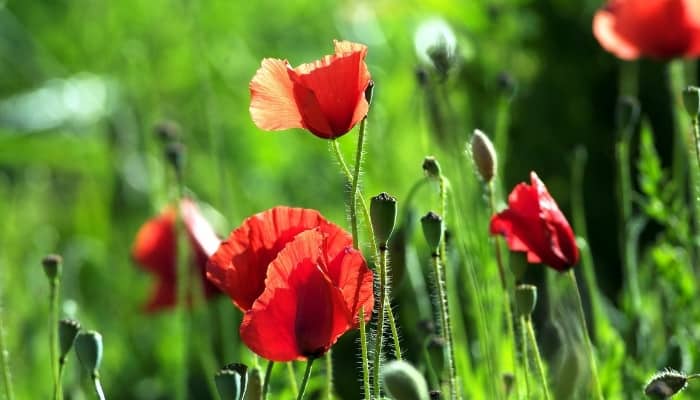
Poppies were first domesticated between 6000-3500 BC by indigenous tribes in Western Europe and are famously associated with the remembrance of fallen soldiers in WWI, and long before that in classical poetry.
Throughout history, poppies have come to symbolize both death and eternal life, viewed as the flower that brings lasting peace to souls.
Light watering is best as too much results in leggy stems.
- Botanical Name: Papaver rhoeas
- Meaning: Death and eternity
- Common Colors: Red, orange, yellow, pink
- Popular Varieties: ‘Ladybird’, ‘Bridal Silk’
- Best for Growing Zones: 6-9
- Light Requirements: 6 hours full sun
#4. Lantana
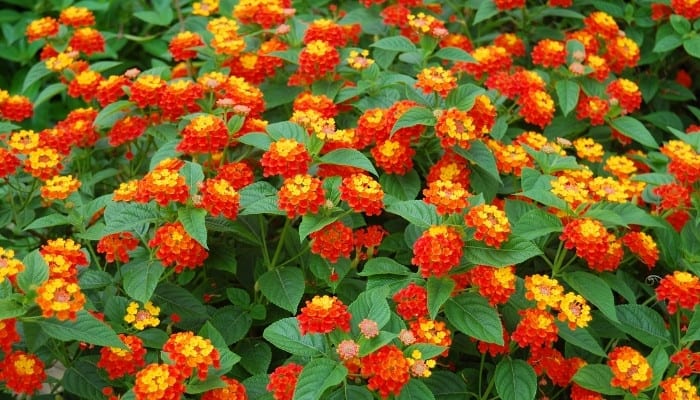
While classed as a weed due to its toxicity and aggressive growth, lantana’s have long been grown for their beauty and healing properties.
The Victorians associated them with “rigor” while traditional Indian medicine used them to treat skin conditions and sexual dysfunction.
Lantanas grow best in moist and slightly acidic soil and will benefit from monthly liquid fertilizer, like Miracle-Gro.
- Botanical Name: Lantana camara
- Meaning: Rigor
- Common Colors: Pink, Red, yellow, purple
- Popular Varieties: ‘Dallas Red’, ‘Athens Rose’
- Best for Growing Zones: 8-11
- Light Requirements: 6-8 hours full sun
#5. Water Lilies
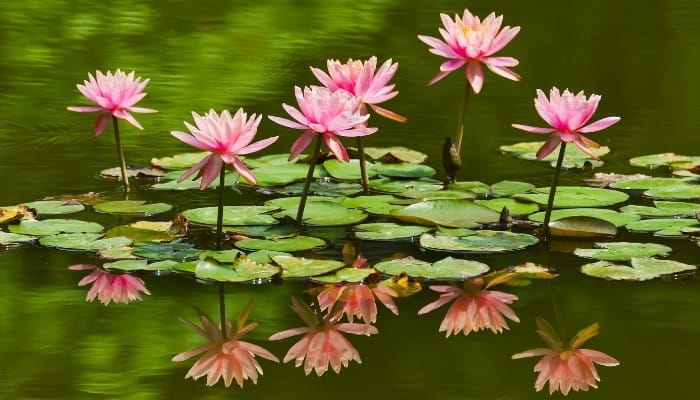
Water lilies have traditionally symbolized resurrection in Buddhist and Hindu faiths and have come to represent “purity of the heart” in contemporary Western culture. They’re often used in modern bridal bouquets.
The pink variety is commonly seen in Spain and will grow equally well in ponds or large containers.
Avoid using rich or organic soil as this will respectively increase algae growth and float away in water. Find tips on planting here.
- Botanical Name: Nymphaeaceae
- Meaning: Resurrection and purity
- Common Colors: Pink, purple, white
- Popular Varieties: White water lily, fragrant water lily
- Best for Growing Zones: 3-10
- Light Requirements: 6 hours full sun
#6. Roses
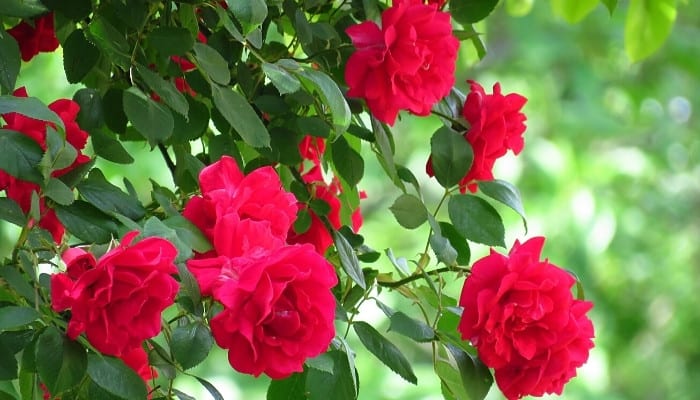
Roses have long symbolized passion and admiration while also extending to war and politics.
They need rich soil to thrive and are hungry flowers, so feed them rose-specific fertilizer (find it here) to help them bloom.
Alhambra palace in Granada teems with roses of all colors in homage to a 17th-century love affair between Queen Isabella’s aide Ruiz de Alarcón and Jacinta, a young lady of the court who wore a rose in her braid.
- Botanical Name: Rosa
- Meaning: Love and passion
- Common Colors: Red, pink, white
- Popular Varieties: ‘Polyantha’, hybrid tea rose
- Best for Growing Zones: 3-10
- Light Requirements: 4-6 hours full sun
#7. Spanish Bluebell
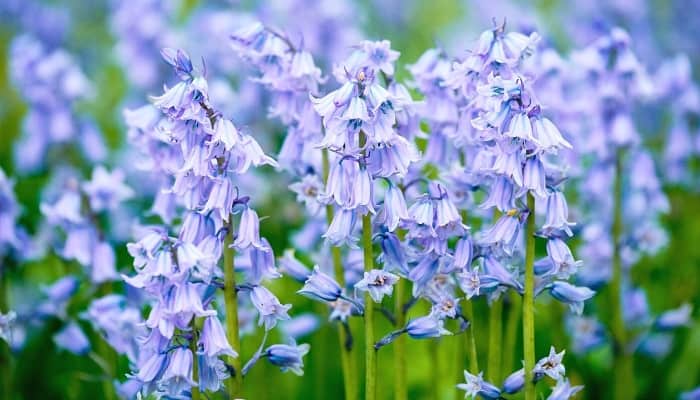
Spanish bluebells are the most resilient member of the bluebell species as they’re tolerant of all-day shade and can be planted almost anywhere in your garden.
Due to their graceful “bowing” nature, Victorians gifted them to people as a sign of humility and gratitude, while medieval folklore viewed them fearfully in the belief that witches hid in bluebell fields after transforming into hares or that fairies would cast a spell if you touched or “rung” a bluebell.
- Botanical Name: Hyacinthoides hispanica
- Meaning: Humility and gratitude
- Common Colors: Blue, pink, white
- Popular Varieties: ‘Dainty Maid’, ‘Excelsior’
- Best for Growing Zones: 3-8
- Light Requirements: Partial shade
#8. Bougainvillea
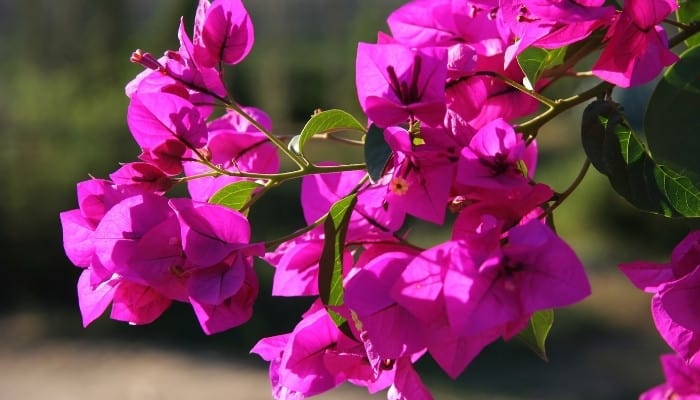
These striking fuchsia-pink flowers are often used to grace entryways and walls in Mediterranean countries to welcome visitors, which fits in with their symbolism of beauty and the desire for harmony between two entities.
As the national flower of Grenada, a garland of Bougainvillea can be found on their coat of arms. These climbers look stunning when grown in large containers or conservatory borders.
- Botanical Name: Bougainvillea species
- Meaning: Peace and beauty
- Common Colors: Pink, orange, purple
- Popular Varieties: ‘Cherry Blossom’, ‘Purple Queen’
- Best for Growing Zones: 9-11
- Light Requirements: 6 hours full sun
#9. Geraniums
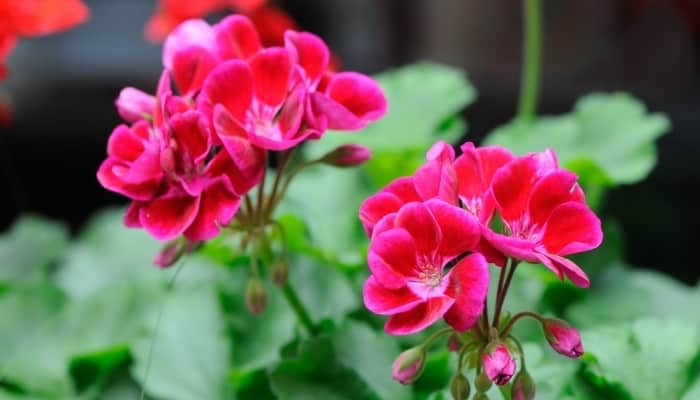
Great as both bedding plants and hanging basket features, geraniums bring bright, bold color to your garden and will need to be overwintered to keep them in good shape.
The name geranium derives from the Greek word géranos meaning “crane” due to the beak-like shape of its seed pod.
These flowers are traditionally presented as house-warming gifts as a symbol of friendship and good health.
- Botanical Name: Pelargonium
- Meaning: Health and friendship
- Common Colors: Purple, pink, red
- Popular Varieties: ‘Rozanne’, ‘Orion’
- Best for Growing Zones: 5-9
- Light Requirements: 4-6 hours full sun
#10. Gazania Flowers
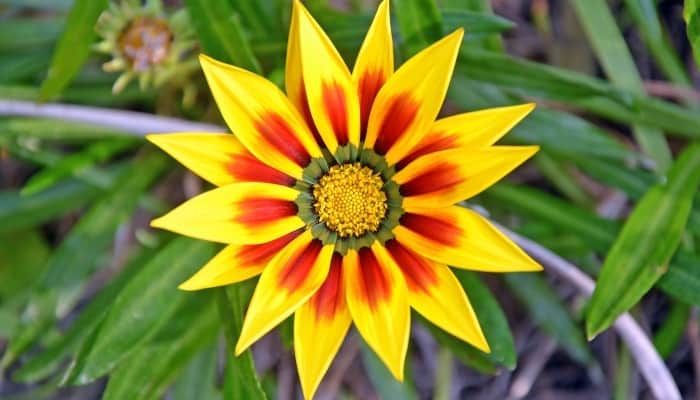
The gazania flower derives its name from Theodorus of Gaza – a 15th-century Greek-Italian scholar, and due to its rich color spectrum, receiving a bouquet is said to symbolize wealth and riches.
Their tough leather-like foliage makes them fairly drought tolerant, so allow the soil to dry out in between watering to prevent fungal issues.
- Botanical Name: Gazania rigens
- Meaning: Fortune
- Common Colors: Orange, yellow, variegated
- Popular Varieties: ‘Kiss Bronze Star’, ‘Tiger Stripe Mix’
- Best for Growing Zones: 4-10
- Light Requirements: 5-6 hours full sun
#11. Orchids
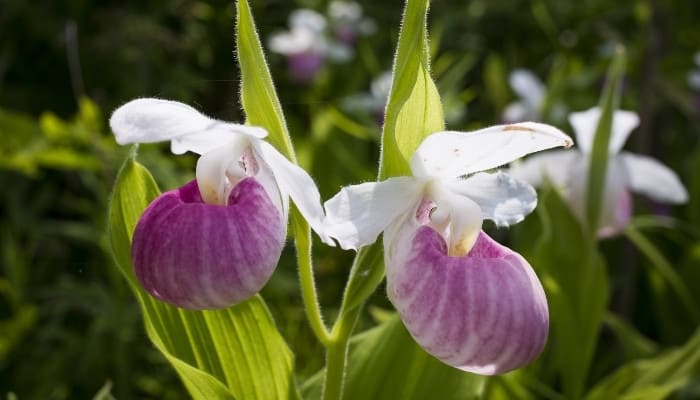
The elegant orchid has historically been viewed as a status symbol by Victorian-era England and by the Ancient Greeks as a mark of virility.
Grecians also believed that consuming certain orchid tubers could determine the sex of their unborn child.
Today, orchids have many uses from edible decoration and vanilla flavoring to floral wedding arrangements.
Your garden orchids will prefer an aerated potting mix, like this one, for improved air circulation.
- Botanical Name: Orchidaceae
- Meaning: Luxury and virility
- Common Colors: Red, orange, white
- Popular Varieties: Moth orchid, slipper orchid
- Best for Growing Zones: 6-9
- Light Requirements: Morning/evening sunlight hours
#12. Lilies
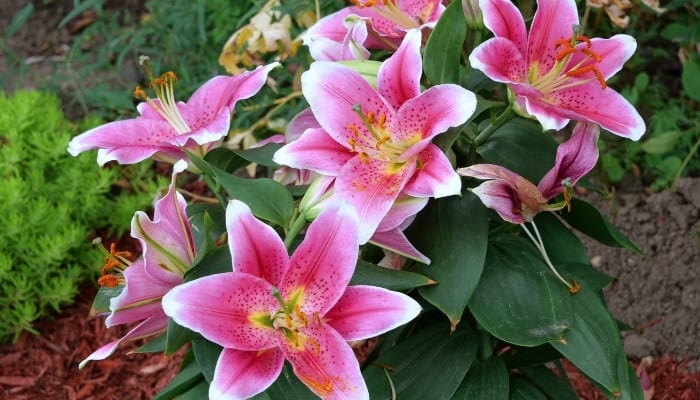
Their fresh fragrance and delicate color palette have associated lilies with many meanings, including femininity (pink), friendship (yellow), and rebirth (white).
It’s even believed that Ancient Romans filled their pillows with lilies due to their sweet scent.
Lily flowers will not grow well in extreme southern climates as their bulbs need to be slightly exposed to the cold to bloom.
- Botanical Name: Lilium
- Meaning: Friendship and rebirth
- Common Colors: White, pink, yellow
- Popular Varieties: Oriental lily, trumpet lily
- Best for Growing Zones: 4-9
- Light Requirements: 6 hours full sun
#13. Anthora
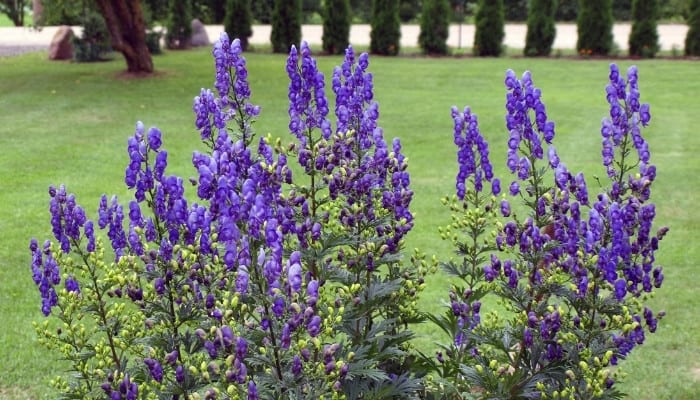
Anthoras are also known as monkshood plants due to their rear sepal shaping which resembles a cowl worn by medieval monks.
An offering of anthora flowers is said to symbolize caution about a threat of treachery.
This figures since anthoras were used in the making of one of the first-ever poisons used in Ancient Greece and were implemented worldwide as a toxin in war and political assassinations.
Avoid planting these in overly rich soil to prevent leggy stems.
- Botanical Name: Aconitum anthora
- Meaning: Danger and betrayal
- Common Colors: Purple, blue, white
- Popular Varieties: ‘Albus’, ‘Blue Sceptre’
- Best for Growing Zones: 3-7
- Light Requirements: 6 hours dappled sunlight
#14. Ornamental Onion
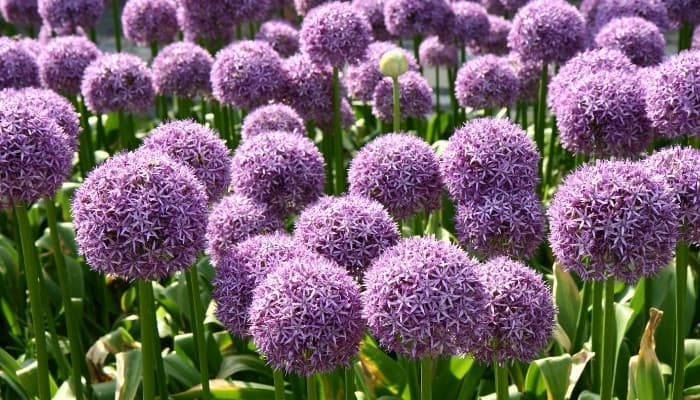
These close cousins of the actual vegetable produce single rounded blooms which grow slowly – symbolizing patience and unity in certain cultures.
The delicate beauty of the ornamental onion was also described by Shakespeare as a flower “capable of moving one to tears.”
When crushed, this inedible flower produces a subtle and thankfully non-tear-provoking onion-like scent.
These will do best when watered infrequently – areas with regular rainfall will help them prosper naturally.
- Botanical Name: Allium
- Meaning: Unity and patience
- Common Colors: Purple, yellow, white
- Popular Varieties: ‘Globemaster’, ‘Schubert Allium’
- Best for Growing Zones: 4-10
- Light Requirements: Part sun/shade
#15. Lacy Self-Heal
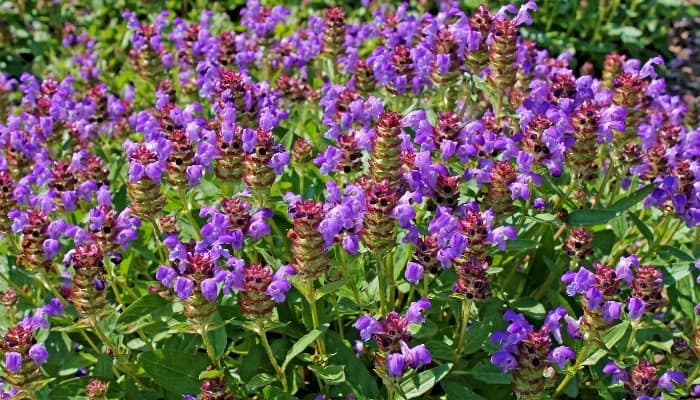
Belonging to the mint family (Lamiaceae) of flowering plants, lacy self-heal is also known as “The Carpenter’s Herb” for its use in herbal medicine for centuries.
Interestingly, contemporary medical research has revealed it to possess some degree of cancer- and virus-fighting properties.
Its scientific name Prunella derives from Die Braune – the German name for the throat inflammation it was said to cure. Lacy self-heal is best suited to growth among other wildflowers.
- Botanical Name: Prunella vulgaris
- Meaning: Curative
- Common Colors: Pink, purple, blue
- Popular Varieties: ‘Lacy Deep Pink’, ‘Bella Blue’
- Best for Growing Zones: 4-9
- Light Requirements: Partial sun/shade
#16. Gray-Leaved Cistus
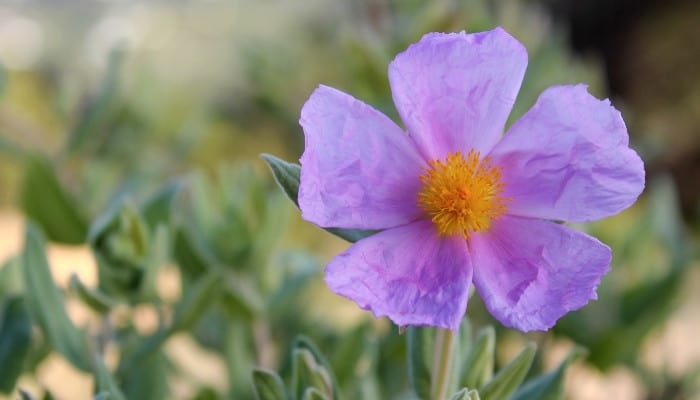
A common sight on the hillsides of Portugal and Spain, these rock roses have tough gray leaves with hot pink flowers that have a contrastingly papery texture.
Despite this, they are very tolerant, appropriately representing endurance and determination.
According to the Victorian practice of floriography (sending coded messages through floral arrangements), the name Cistus means “popular favor.”
Bring out the best in this odd flower with infrequent watering.
- Botanical Name: Cistus albidus
- Meaning: Endurance
- Common Colors: Pink, white, purple
- Popular Varieties: White-leaved rock rose, sun rose
- Best for Growing Zones: 8-10
- Light Requirements: 6 hours full sun
#17. Daisies
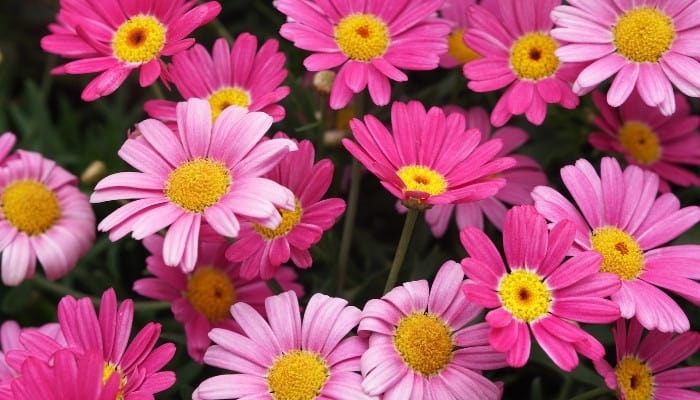
Available in many colors, this garden favorite has various meanings depending on the color variety.
The classic white English daisy symbolizes innocence (appropriately, the Girl Scouts use daisies in their first level badge), while the bolder orange and yellow daisies represent hope, joy, and fun.
Be sure to deadhead fading blooms to encourage healthier growth, and apply mulch to the soil in spring to help combat weeds.
- Botanical Name: Bellis perennis
- Meaning: Hope and innocence
- Common Colors: White, red, pink
- Popular Varieties: Shasta daisy, English daisy
- Best for Growing Zones: 5-8
- Light Requirements: 6 hours full sun
#18. Lilacs
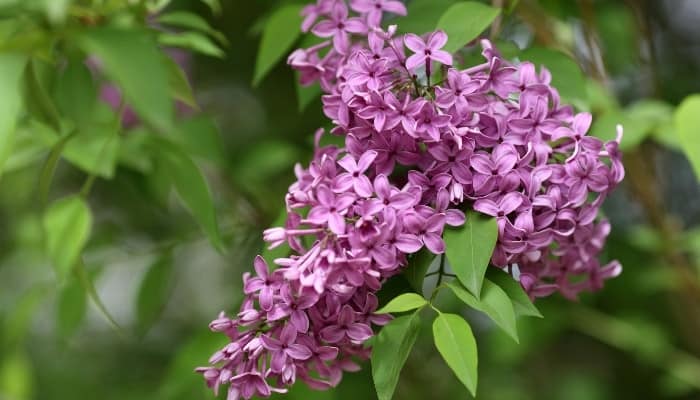
Their powerful aroma and rich tones have made lilacs a popular landscaping feature for centuries, and today the state of New Hampshire in New England has made the lilac its official flower.
While these flowers generally represent confidence, specific color varieties carry different meanings – including purity (white), spirituality (purple), and tranquility (blue).
Leave at least 10 feet of garden width to plant your lilac shrub as they require lots of space.
- Botanical Name: Syringa vulgaris
- Meaning: Confidence and spirituality
- Common Colors: Purple, pink, blue
- Popular Varieties: ‘Yankee Doodle’, ‘Primrose’
- Best for Growing Zones: 5-7
- Light Requirements: 6 hours full sun
#19. Alstromeria
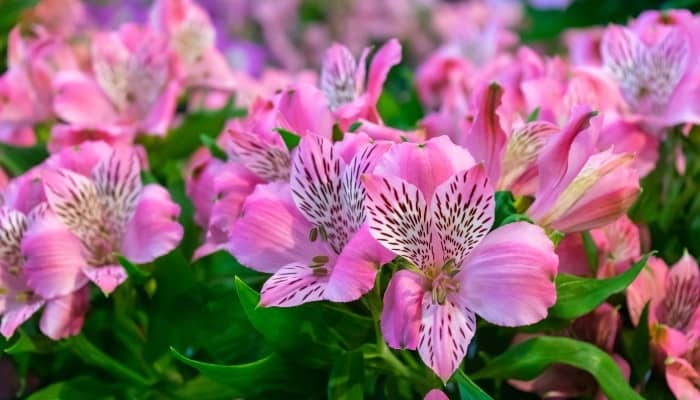
Dubbed the Peruvian lily, these artistic-looking blooms come in a rainbow of bold, passionate shades and were first discovered by the Swedish botanist Clas Alströmer in 1753 while exploring the Andes.
Alstromerias have come to represent friendship and support and are a popular choice for “Thinking of you” flowers. Opt for richly organic compost and use a granulated fertilizer upon planting.
- Botanical Name: Alstroemeria
- Meaning: Devotion and friendship
- Common Colors: White, pink, yellow, red
- Popular Varieties: ‘Adonis’, ‘Butterscotch’
- Best for Growing Zones: 8-10
- Light Requirements: Full morning sun
#20. Sunflowers
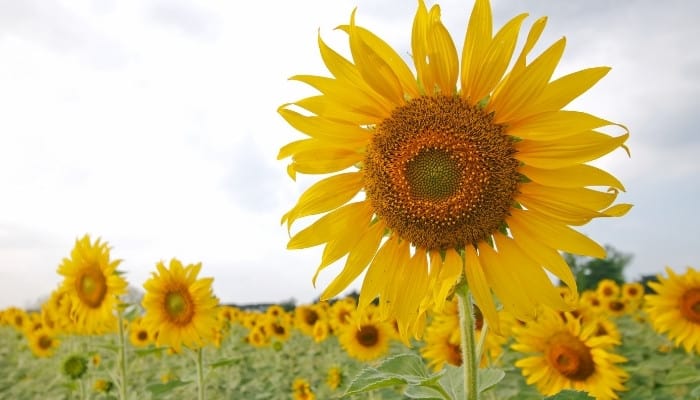
Endlessly eye-catching and cheerful, sunflowers were historically revered by sun worshippers in early Peru and treasured by Native Americans for their bounty and vivid pigment.
They have also tricked 16th-century Spanish explorers into believing the flowers were made from real gold. Since then, the sunflower has come to symbolize many things from false riches to joy and energy.
Encourage your sunflowers to grow gloriously with the aid of support stakes and tomato feed once they flower.
- Botanical Name: Helianthus annuus
- Meaning: Vitality and joy
- Common Colors: Gold, red, orange
- Popular Varieties: ‘Early Black Heart’, ‘Helios Flame’
- Best for Growing Zones: 4-9
- Light Requirements: 6-8 hours full sun
#21. Lavender
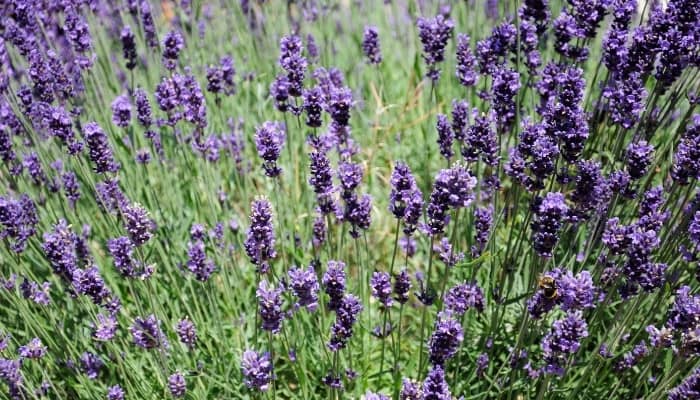
Beloved for millennia for its relaxing and antiseptic properties, lavender is symbolic of peace and serenity and derives its name from the Latin word lavare meaning “to wash.”
Ancient Romans regularly used the oils in their baths and bedding.
Strangely, Spanish varieties produce heavily-scented foliage instead of the flowers, which float butterfly-like from their cone-shaped spikes.
Water these drought-tolerant flowers only once the soil is completely dry.
- Botanical Name: Lavandula
- Meaning: Serenity and grace
- Common Colors: Violet, purple, pink, red
- Popular Varieties: ‘Ballerina’, ‘Kew Red’
- Best for Growing Zones: 7-9
- Light Requirements: 6 hours full sun
Conclusion
In summary, these breathtaking Spanish flowers can bloom in your garden with an ample amount of daily sunlight (or dappled light and shade for more delicate species).
As well as a mild, sunny climate, many require well-draining, organic-rich soil to grow healthy and produce abundant blooms.
Specific fertilizer is also essential for strong development in some, so be sure to research the ideal growing culture of your favorite flower and watch them flourish!

